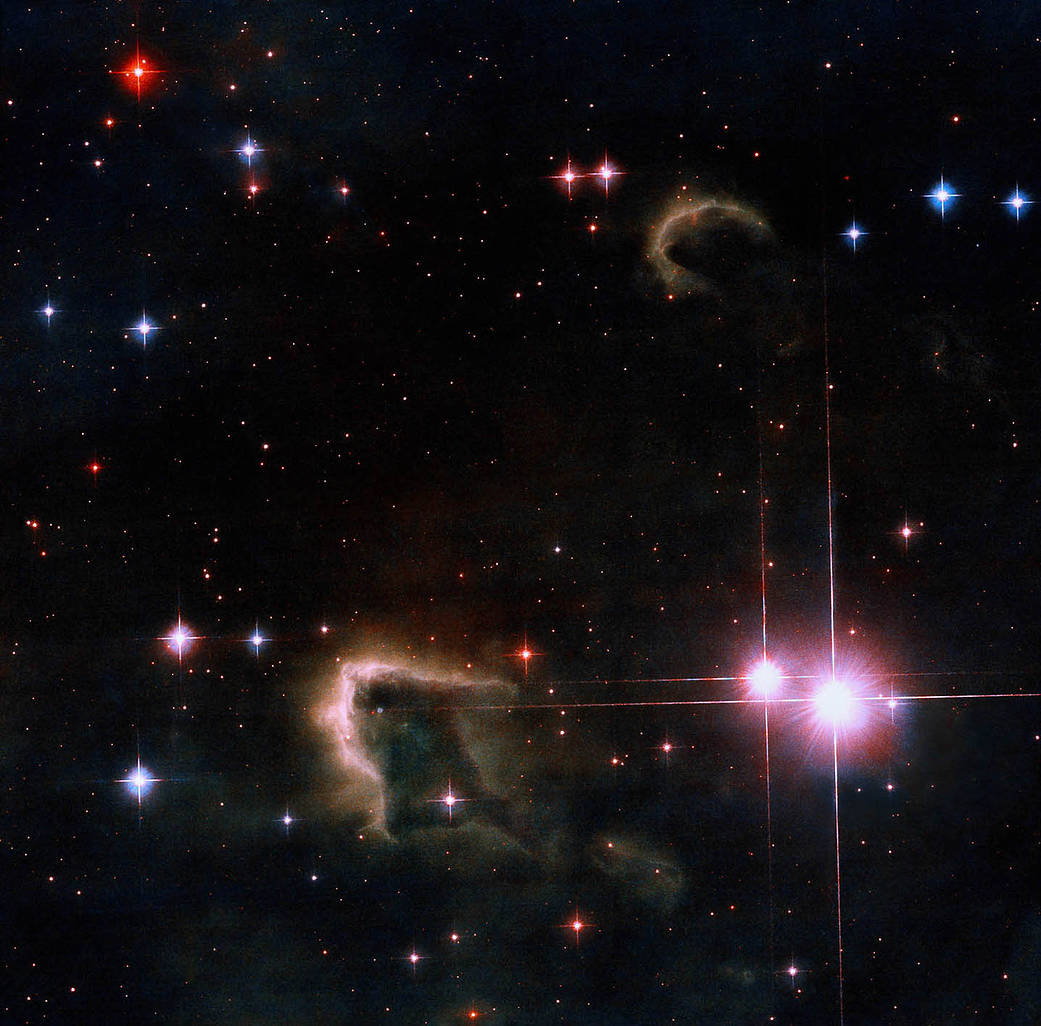Star formation is a complex process. But in simple terms, a star forms due to clumps and instabilities in a cloud of molecular hydrogen called a Giant Molecular Cloud (GMC). As more and more gas accumulates and collapses inward, the pressure becomes immense, the gas eventually heats up to millions of degrees, and fusion begins.
But what happens to the gas that remains as the young star forms? Some of it can form a type of dark halo called a frEGG—a free-floating Evaporating Gaseous Globule. And, proving that the Universe is indeed strange, the frEGG itself can contain another stellar embryo. The frEGG can be quite opaque, making it difficult to observe the star’s formation process in all its complexity.
We’ve known about frEGGs since 1995 when the Hubble Space Telescope captured its famous image of the Eagle Nebula. Hubble spotted them at the end of long fingers of gas.

When a star begins its life of fusion, its ultraviolet radiation causes the surrounding gas in the GMC to dissipate by photoevaporation. But not all of it. The frEGG, which is made of colder denser gas, can withstand photoevaporation for a period of time. Once the other gas has been dissipated, the frEGG becomes visible. And some frEGGS can contain young stars of their own in the act of forming.
The frEGG is like a cocoon of cold gas that surrounds a young, newly-forming star. They’re cold and dark and difficult to see. The frEGG acts like a veil that obscures the detail in the star formation process.

Credits: NASA, ESA, R. Sahai (Jet Propulsion Laboratory), and DSS; Processing: Gladys Kober (NASA/Catholic University of America)
“For a long time astronomers have speculated about what processes control the sizes of stars – about why stars are the sizes that they are,” said Jeff Hester of Arizona State University, Tempe, AZ. “Now in M16, we seem to be watching at least one such process at work right in front of our eyes,” Hester said in 1995 about the now-famous Hubble image.
A star’s mass determines its fate. Ultra-massive stars burn hot and fast and die out after a few million years. Low-mass stars like red dwarfs smoulder away for trillions of years. “Average” mass stars like our Sun have lifespans of about 10 billion years. But what determines a star’s initial mass?
That’s something that astrophysicists aren’t totally certain about. And part of the reason for their uncertainty is the difficulty of watching young stars form.
Usually stars form in groups inside a GMC. Astrophysicists have questions about how the local environment in the cloud around a star shapes its initial mass and the type of star it becomes. They’re finding more and more frEGGs, and their observations promise to advance our understanding of the star formation process inside these unusual objects. In 2017, the author of a Hubble observing proposal wrote that “By virtue of their distinct, isolated morphologies, frEGGS offer us an exciting, new “clean-cut” probe of the star formation process in the vicinity of massive star clusters.”
Astronomers have observed frEGGs in different stages of photoevaporation as the frEGGs become easier to see. According to a Hubble press release, this is giving astronomers “… an unprecedented look at what stars and their surroundings look like before they are truly stars.”
“This is the first time that we have actually seen the process of forming stars being uncovered by photoevaporation,” Hester emphasized. “In some ways, it seems more like archaeology than astronomy. The ultraviolet light from nearby stars does the digging for us, and we study what is unearthed.”

When a massive new star starts to shine while still within the cool molecular cloud from which it formed, its energetic radiation can ionize the cloud’s hydrogen and create a large, hot bubble of ionized gas. Amazingly, located within this bubble of hot gas around a nearby massive star are the frEGGs: dark compact globules of dust and gas, some of which are giving birth to low-mass stars. The boundary between the cool, dusty frEGG and the hot gas bubble is seen as the glowing purple/blue edges in this fascinating image. Image Credit: ESA/Hubble & NASA, R. Sahai.
Since frEGGs are regions of dense gas, it’s reasonable to think that stars form inside them. But as it turns out, not all frEGGs are incubating young stars. In a 2002 paper, a pair of researchers observed 73 frEGGs in the Eagle Nebula and found that only 15% of them had young stars forming inside them. Most of them were low-mass stars or brown dwarfs. However, the authors say that the 15% number is likely a lower threshold; many of the frEGGs are too opaque to see inside.
Astronomers think that our own Sun formed inside a frEGG. So studying distant frEGGs gives researchers a look at an analog of our early Solar System.
More:
- Press Release: Hubble Spots Dark Star-Hatching frEGGs
- ESA: A frEGGS-plosion of Star Formation
- Universe Today: Astronomers Can Predict When a Galaxy’s Star Formation Ends Based on the Shape and Size of its Disk

